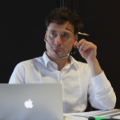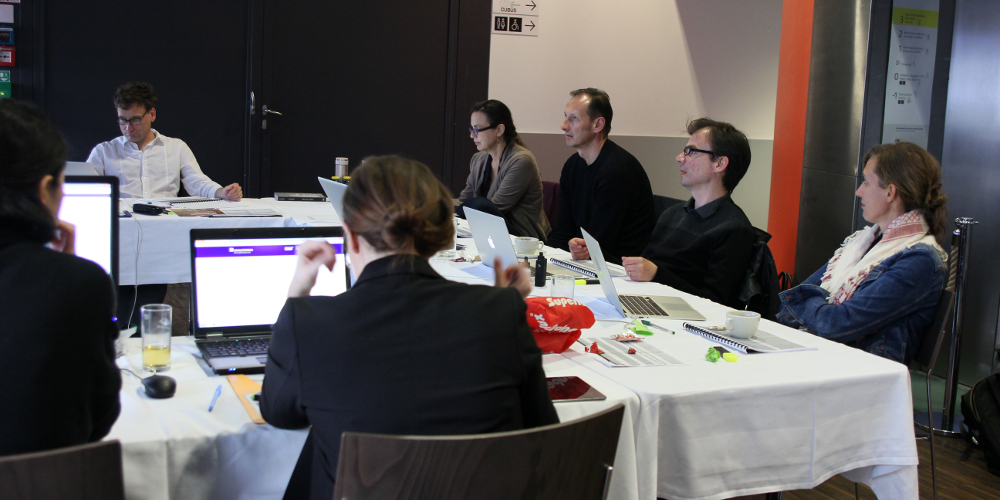Jens Hauser is a curator, a scholar in media & cultural studies, and a journalist who writes about cultural matters. He’s curated some of the best-known exhibitions at the interface of art and biology — for example, “Still, Living” (2007) at the Biennale of Electronic Arts Perth, “sk-interfaces” (2008) produced for Liverpool’s European Capital of Culture year, and “synth-ethic” (2011), an exhibition at Vienna’s Natural History Museum about art in the context of synthetic biology.
Jens Hauser’s works limn the challenges of the new “bio-media” that far exceed the possibilities and boundaries of previous media and have been increasingly employed artistically in recent years. So-called Bio Art is one of the tendencies in the genre of hybrid art, one of this year’s six Prix Ars Electronica categories and the one in which Jens Hauser served as juror.
While the juries were convening in Linz, we had a chance to talk to him about “bio-mediality” and the boundary separating a work of art from a scientific experiment. One of the things we found out was that, perhaps, Bio Art doesn’t even exist.
 The winning project of the category Hybrid Art of the Prix Ars Electronica 2015: Plantas Autofotosintéticas from Gilberto Esparza (Credit: Gilberto Esparza)
The winning project of the category Hybrid Art of the Prix Ars Electronica 2015: Plantas Autofotosintéticas from Gilberto Esparza (Credit: Gilberto Esparza)
At college, you majored in film & TV, media studies and science journalism. When did you discover your interest in art and biology? What fascinates you at the nexus of these two fields?
Jens Hauser: After graduating from high school, I couldn’t decide whether to take biology or media studies and film. So ever since, this momentous decision has been on my mind because, after all, you ask yourself occasionally if you made the right choice. Following a phase in cultural & scientific journalism, I became aware that art with so-called new media wasn’t based solely on physical and electronic media any more but rather increasingly on biological or bio-technical processes. This created an opportunity for me to take up my original urge to study living processes and combine it with artistic activities. What I find particularly interesting is that the entire history of art is actually pervaded by allusions to life, representations, imitations and simulations of life, and now manipulations of it too. From this perspective, the whole of art history is also the history of what’s alive. When you consider the early anthropomorphic statues and hydraulic automatons from Byzantium, and the definition of a work of art itself as an organism, and extrapolate this line of reasoning all the way to so-called genetic art, then you realize that this fascination with that which is alive has always been at the core of art.
Today we’ve reached a new plane on which artists are actually staging biological processes on a microscopic level.
This hybrid form of art and biology is often referred to as Bio Art, but there have been extensive discussions among artists about what exactly that is. What do you understand Bio Art to be? Is it even the proper designation for this artistic genre?
Jens Hauser: There is no Bio Art. Or there’s only Bio Art, if art is something that always involves an observer, and at least this person beholding it is always biological. The interesting thing about art that, in a physical sense, stages, simulates or manipulates living processes is that it engenders a sort of observation on a second level whereby a living system is confronted by or interacts with another living system. What’s misleading about the term Bio Art is that it, in principle, reduces the radius of interaction to the biological “object” regardless of this special situation in which a human being as biological observer is beholding a biotechnological aesthetic object, and thus also a subject. But this is actually the fascinating thing about art like this. And that’s precisely why some people’s reactions to these works are so highly perturbed—because we know very well or we feel that we’re created in the same materiality as the aesthetic “object” that we’re beholding at the moment. Furthermore, the term Bio Art is often employed very indiscriminately—for example, by artists who apply it to their painting robots or chromosome-shaped classical sculptures. Moreover, Bio always depends on which characteristic of a living creature one accentuates and which is relegated to secondary importance. After all, the question of what constitutes life is a highly philosophical issue, as we’re all aware.
You’ve formulated a theory of bio-mediality. What exactly is that?
Jens Hauser: I wrote my dissertation as a theory of bio-mediality in which I analyze which of the currently existing media based on storage, transfer and processing of information by electronic or physical means correspond to biological phenomena. I investigated what can be done in the Biotech Age under the influence of so-called convergence technologies of biological media, and what they potentially add in the form of organic media functions—for instance, adapting and repairing themselves. Bio-mediality encompasses, for example, processes that are inherent in the structure of living things and, as a result of which, the concept of media we now use has to be broadened.
I have high regard for Austrian media theorist Walter Seitter and his Physics of Media. Now, I’ve attempted to write a Biology of Media. If you ask biologists to bring their medium along with them, then they don’t show up with a TV set but rather a container of growth medium. In this sense, media are understood as “conditions that are conducive” and not just as radios or computers. We’ve gotten accustomed to a very one-dimensional definition of media, but we have to realize that there are other definitions in which a medium is understood as a milieu, a means with which one can make something, or also as a standard of measurement. And all of these functions that are normally based on electronic, mechanical apparatuses can also be transferred into the biological realm.
Bio Art is often situated amidst blurred borders separating art and science. A well-known and controversial example is the fluorescent rabbit by Brazilian artist Eduardo Kac. Where’s the boundary between a work of art and a scientific experiment? What role do ethics play in Bio Art?
Jens Hauser: First off, ethical issues are usually central matters in so-called Bio Art because, of course, they deal with living processes and, ethically speaking, they’re initially subject to the same rules that apply in laboratories. Now here, for example, Kac’s performative action “GFP Bunny” calls into question the standards that are applied in the laboratory, always with the aim of achieving progress for the “human animal,” by asking to what extent absolutely everything can be justified in the name of humankind. Kac wanted to make a laboratory object into a social subject. Many of these projects call into question what it means to be a human being per se, and our status as the purported crown of creation. The direction of the ethical thrust is then also in a totally different direction: it doesn’t only question whether it’s permissible for an artist to do something or another; this is also a matter of what humankind may dare to to—for example, in conjunction with scientific research.
The dividing line between art and science is, in my opinion, rather one between art and techno-science since, in most cases, this has less to do with processes meant to yield insights than with the technical application of conditions that are conducive to development. In the case of Eduardo Kac, this was more of a re-appropriation in which an accepted scientific tool is used for aesthetic purposes and thus in another way than the one for which it was meant. In this artistic genre, such re-appropriation is often central, but, of course, there are projects in which there is also the prospect that they actually will yield knowledge, alternative insights. Here, I’m thinking of, for example, projects by Adam Brown who, at Michigan State University together with physiologist Robert Root-Bernstein, created a series of installations entitled “Origins of Life” in which experiments conducted in the 1950s and ‘60s were repeated and restaged. These experiments demonstrated that amino acids, the building blocks of life, could be produced out of simple chemicals, gases and energy. Brown and Root-Bernstein created a whole series of these “Origins of Life” installations and derived from them scientific insights that would have been impossible to finance in research today. There are examples in both directions in which cross-fertilization is evident.
 The jury of the category Hybrid Art: Jens Hauser, Jurij V. Krpan, Susanne Jaschko, Victoria Vesna und Filip Visnjic (f.l.t.r.), Credit: Florian Voggeneder
The jury of the category Hybrid Art: Jens Hauser, Jurij V. Krpan, Susanne Jaschko, Victoria Vesna und Filip Visnjic (f.l.t.r.), Credit: Florian Voggeneder
You were a juror in the Hybrid Art category. What, in your opinion, does it take for a project to win a Golden Nica?
Jens Hauser: I believe that, especially in the Hybrid Art category today, you can no longer evaluate strictly the effects, functions and forms. In principle, you have to read the media behind it and base your assessment on how they all mesh, and how, by means of this new hybrid interconnection, they stimulate new, unprecedented conceptual linkups. It’s also interesting when the condensation of very dissimilar aesthetic domains, qualities or areas of knowledge that, at first glance, are very far removed from one another opens up new conceptual spaces, and this often in a form that unsettles, surprises, but, above all, revises conventional epistemological points of view. And in my opinion, projects in the Hybrid Art category in recent years have achieved this.

Jens Hauser is a Paris and Copenhagen based art curator and media studies scholar focusing on the interactions between art and technology. He holds a dual research position at both the Department of Arts and Cultural Studies and at the Medical Museion at the University of Copenhagen, and is a distinguished affiliated faculty member of the Department of Art, Art History and Design at Michigan State University. His curated exhibitions include L’Art Biotech (Nantes, 2003), Still, Living (Perth, 2007), sk-interfaces (Liverpool, 2008/Luxembourg, 2009), the Article Biennale (Stavanger, 2008), Transbiotics (Riga 2010), Fingerprints… (Berlin, 2011/Munich/2012) and Synth-ethic (Vienna, 2011).
2,889 works from 75 countries were submitted for prize consideration this year to the Prix Ars Electronica. The names of the prizewinners—in Hybrid Art and all other categories—are online at https://ars.electronica.art/prix/gewinner/.
Details and interviews with the prizewinners will soon be appearing on our Blog!

